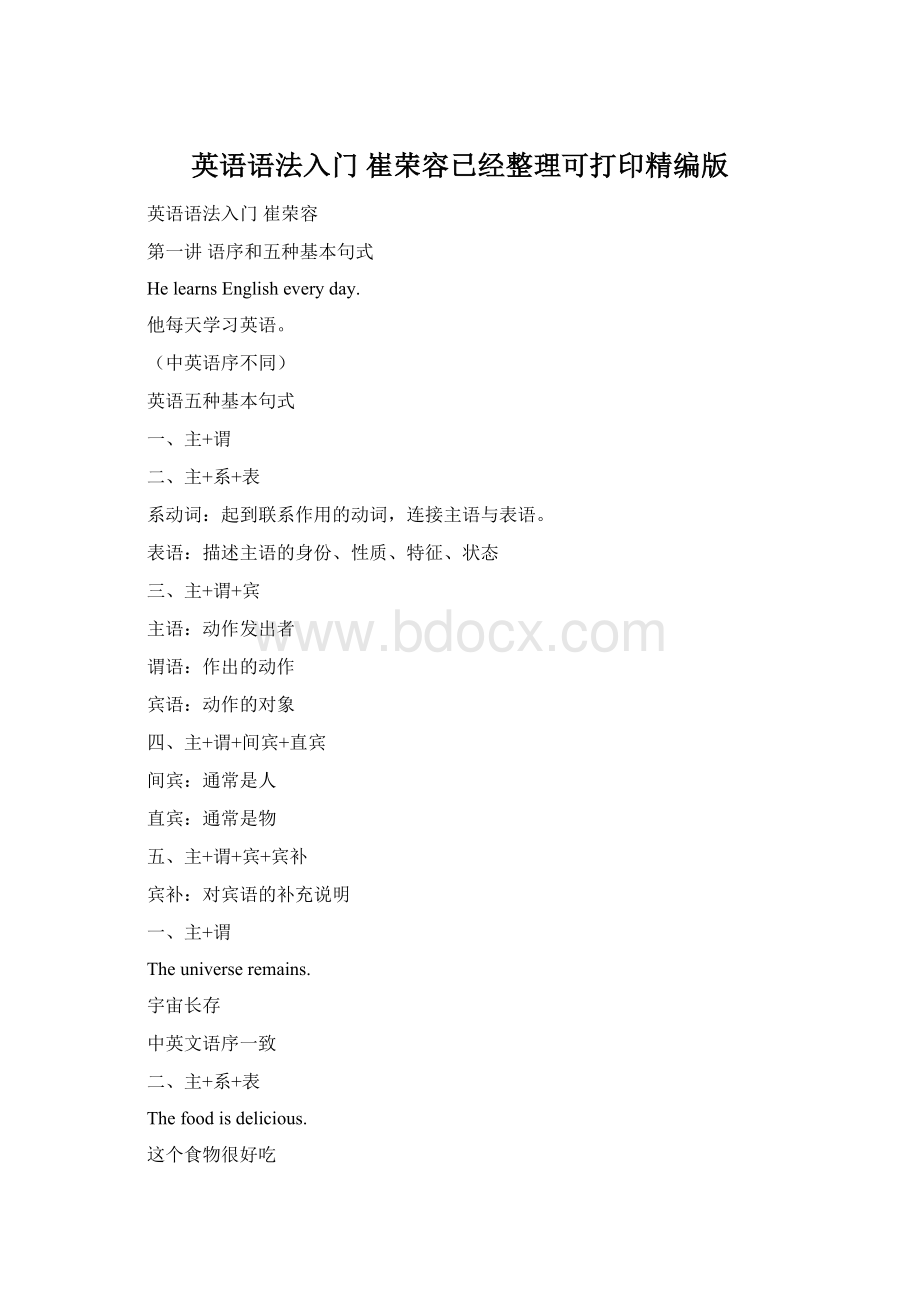英语语法入门 崔荣容已经整理可打印精编版文档格式.docx
《英语语法入门 崔荣容已经整理可打印精编版文档格式.docx》由会员分享,可在线阅读,更多相关《英语语法入门 崔荣容已经整理可打印精编版文档格式.docx(32页珍藏版)》请在冰豆网上搜索。

我们选他当班长
(him与ourmonitor,都是指同一个人,ourmonitor是对him的补充说明)
Nothingisimpossibletoawillingheart!
有志者事竟成!
第二讲be动词的形式和用法
一、be动词的形式:
be、am、is、are、was、were、being、been
1、Themanisback.
2、Theyareback.
3、Hewasback.
4、Theywereback.
5、Theyhavebeenback.
6、I’llbeback.
上述“back”是副词,构成主系表结构。
二、be动词的用法:
起到联系前后的作用(一般翻译为“是”,或无实意而不作翻译),多用于主系表结构。
后面接名词、形容词、地点副词或短语作补足语成分。
1、Themanisateacher.ateacher是名词
2、Mary’snewdressesarecolorful.colorful是形容词
3、Mymotherwasinthekitchen.inthekitchen是地点副词。
4、Iam20.数词也可做表语
5、It’sme.代词也可做表语
三、be动词的练习
1、他们是老师
Theyareteachers.
2、他曾是一名老师
Hewasateacherbefore.
3、他已经当了3年的老师
Hehasbeenateacherfor3years.
第三讲be动词的否定/提问/回答
一、be动词的否定
在am、is、are、was、were后面加not
缩略式amnot,isn’t,aren’t,wasn’t,weren’t
1、Themanisn’tback.
2、Iamnotback.
3、Theyaren’tback.
4、Hewasn’tback.
5、Theyweren’tback.
二、使用be动词提问和回答
Isheateacher?
Yes,heis./No,heisn’t.
Areyouateacher?
Yes,Iam./No,Iamnot.
Weretheyteachers?
Yes,theywere./No,theyweren’t.
三、be动词的练习:
1、他是医生吗?
Isheadoctor?
不,他不是
No,heisn’t.
2、他们昨天在教室吗?
Weretheyintheclassroomyesterday?
3、他们昨天不在教室
Theyweren’tintheclassroomyesterday.
第四讲代词的主格和宾格
主格代词:
Ihesheityouwethey
1、Iamateacher.
2、Heisateacher.
3、Youareteachers.
宾格代词:
mehimherityouusthem
1、Helikesme.
2、Welikeher.
3、Ilikethem.
练习
1、我喜欢它
Ilikeit.
2、他们认识他
Theyknowhim.
第五讲名词性/形容词性物主代词
形容词性物主代词:
(后接名词)
单数形式:
myyourhis/her/itsone’s
复数形式:
ouryourtheir
1、Thisismybook.
2、Weloveourmotherland.
3、Thoseareyoursocks.
名词性物主代词:
mineyourshis/hers/itsone’s
oursyourstheirs
1、Thebookisours.
2、Theappleishers.
1、我的老师是中国人
MyteacherisChinese.
2、这个电脑是他们的
Thiscomputeristheirs.
3、我们的书在书架上
第六讲反身代词
单数myselfyourselfhimselfherselfitself
复数ourselvesyourselvesthemselves
反身代词的用法:
(指某人自己,通常是主语的“自己”)
1、Pleasehelpyourselftosomefish.请随便吃些鱼吧
yourself在动词help后作宾语;
2、Weenjoyedourselveslast;
ourselves在动词enjoyed后作宾语;
3、Thethingitselfisnotimp;
反身代词itself在名词Thething后作同;
练习;
1、Takegoodcareof(yoursel;
2、Shegainedcontrolof(her;
第七讲实意动词的
yourself在动词help后作宾语。
2、Weenjoyedourselveslastnight.我们昨晚玩得很开心
ourselves在动词enjoyed后作宾语。
3、Thethingitselfisnotimportant.这件事本身不重要
反身代词itself在名词Thething后作同位语,起到解释、说明名词的作用。
1、Takegoodcareof(yourself)照顾好?
?
2、Shegainedcontrolof(herself)控制住了?
第七讲实意动词的特征
实意动词comegoreadwatchplayfly
1、HecomesfromShenyang.
实意动词comes作谓语,后接介词短语fromShenyang作宾语动词come有一般现在时“单三”的变化
2、Sheisreadingstorybooks.
实意动词reading作谓语,后接动词storybooks作宾语动词read有现在进行时的变化
3、TheywenttoAmericayesterday.
动词go有一般过去时“went”的变化
4、Wehavewatchedthegameforthreetimes.
动词watch有现在完成时“watched”的变化
现在完成时:
动作已经发生或对现在造成影响
5、MymotherwillflybacktoChinanextmonth.一般将来时:
will+动词原形
总结:
实意动词有时态与数量(三单)上的变化
练习:
1、他昨天来上海了
HecametoShangHaiyesterday.
2、我们正在写作业
Wearewritinghomework.
3、他们读这本书已经读3遍了
Theyhavereadthisbookthreetimes.
第八讲实意动词的否定/提问/回答
(一般现在时与一般过去时)
使用助动词进行否定
在助动词dodoesdid后面加not
donot/don’t
doesnot/doesn’t
didnot/didn’t
例句:
1.Idon’tgotoschoolbybus.
2.Shedoesn’twatchTVeveryday.
3.Theydidn’tswimlastnight.
使用助动词进行提问
1.Heoftenplaysgolf.
Doesheoftenplaygolf?
Yes,hedoes./No,hedoesn’t.
2.Theygotoschoolbybus.
Dotheygotoschoolbybus?
Yestheydo./No,theydon’t.
3.Samhadbreakfastyesterday.
DidSamhavebreakfastyesterday?
Yes,hedid./No,hedidn’t.
1.他每天都学英语吗?
DoeshelearnEnglisheveryday?
是的,他每天都学英语
Yes,hedoes.
2.Tom昨天没吃早饭
Tomdidn’thavebreakfastyesterday.
第九讲使用疑问词进行提问和回答
(1)
使用疑问词进行提问
when,where,who,what,how
时间、地点、人物、干什么、怎样
例句Heboughtthreebooksyesterday.
123
1.Whoboughtthreebooksyesterday?
对主语提问,原语序不变
2.Whatdidhebuyyesterday?
对宾语提问时,将助动词提前,并还原动词。
3.Whendidhebuythreebooks?
对状语提问时,将助动词提前,并还原动词。
TheywantedtogotoShangHaibyair.
1.WhowantedtogotoShangHaibyair?
2.Wheredidtheywanttogobyair?
3.HowdidtheywanttogotoShangHai?
第十讲使用疑问词进行提问和回答
(2)
howlong,howfar,howoften,why
多长时间,多远,多长时间一次,为什么
1.TheyhavebeeninChinaforthreeyears.
HowlonghavetheybeeninChina?
对时间状语提问2.Itisabout4000kilometersfromBeijingtoXi’an.HowfarisitfromBeijingtoXi’an?
3.Theycometovisitmeonceaweek.
Howoftendotheycometovisitme?
4.Shecamelate,becauseshemissedthebus.
Whydidshecomelate?
1.他们学汉语多长时间了?
HowlonghavetheylearnedChinese?
2.你多长时间看一次电影?
Howoftendoyouwatchmovies?
3.你的家离学校多远?
Howfarisitfromyourhousetoyourschool?
第十一讲名词
代表事物的词,包括具体和抽象的事物
名词分两类:
1.可数名词:
是指数得过来的概念。
如apple\pencil\student
可数名词有单数和复数之分
apple-apples
pencil-pencils
tomato-tomatoes
2.不可数名词:
无法计算的数量或抽象概念。
如
salt\coffee\water\(history\love抽象)
不可数名词无复数,只用单数表示
salt-salt
coffee-coffee
water-water
3.可数名词变复数规则:
(1)一般末尾加后缀-s,friend-friends
(2)以s\z\x\ch\sh结尾的词,在该词末尾加后缀-es,bus-buses
(3)辅音字母+y结尾的名词,将y改变为i,再加es,
candy-candies(除aeiou以外的字母为辅音
字母)
(4)以-o结尾的名词,如果不是外来词或缩写,就加-es.
tomato-tomatoes,hippo-hippos缩写
(从非英语国家引进的词汇为外来词,如madam是
从法国引进的外来词)
3、可数名词前可加a(an)或量词,有复数变化
以元音开头的名词前加an,以辅音开头的名词前加a,表示一个。
apple——anapple——apples
——aboxofapples量词
Tomato——atomato——tomatoes
——abagoftomatoes量词
4、不可数名词前不可加a(an),没有复数,但前面可以加量词。
Coffee——acupofcoffee
Heboughtme(aboxofchocolate)一盒巧克力
(abike)一辆自行车;
第十二讲代词:
指示代词和不定代词;
指示代词(特指):
标识人或事物的代词,用来代替前;
常用的:
this\these\that\thos;
不定代词(泛指):
指代不确定的人或事物;
one\theother\some\an;
1.(These)teachersarefrom;
这些教师都是中国来的;
2.Iknow(nothing)
(abike)一辆自行车
第十二讲代词:
指示代词和不定代词
标识人或事物的代词,用来代替前面已提到的名词。
this\these\that\thoseThisishisbook.Thoseappleswerehis.
指代不确定的人或事物。
one\theother\some\any\something\nothing例:
Nooneknowswhereheis.没人知道他在哪儿SomeoftheboyswanttogotoShanghai,buttheotherswanttogotoXi’an.一些男孩想去上海,其他人想去西安Eachofthestudentshasgotabook.每个学生都有一本书。
1.(These)teachersarefromChina.
这些教师都是中国来的。
2.Iknow(nothing)aboutthisperson.
我对这个人一无所知
3.Ihave(something)totellyou.
我有事要告诉你
第十三讲形容词
1、形容词通常形容人或事物的状态、性质、大小等,通常用在名词前,be动词后
beautiful-beautifulgirl
Thegirlisbeautiful.
2、The+形容词=复数名词(表示一类),作主语时,后面的动词
使用复数的相应格式。
old-theold老的—老年人(一类人、复数名词)young-theyoung年轻的—年轻人(一类人、复数名词)Theoldneedmorecarethantheyoung.Theold是复数名词,后面的动词need不能用三单的格式。
3、练习:
(1)Sheisa(good)student.
她是一个好学生。
(2)Thisbikeis(expensive)
这辆自行车很贵
(3)(Therich)sometimescomplaintheiremptylife.富人有时抱怨他们空虚的生活
第十四讲副词
1、副词可以修饰动词、形容词、其它副词以及其他结构。
一般表程度。
Herunsfast.
Sheisverybeautiful.very修饰形容词beautifulTheyworkveryhard.
副词的位置
(1)根据情况,放在助动词之后,实意动词之前或之后
(2)形容词之前,其它副词之前或之后
(3)多个助动词时,副词一般放在第一个助动词后Hespeaksveryfast.
fast在实意动词speak之后,在其它副词very之后。
Theyhavealreadyleft.already在助动词have后Theyhavealreadybeenrepaired.already在第一个助动词have后
2、常用的频度副词
(always\usually\often\sometimes\never?
)的位置通常放在实意动词前面,be动词后面,助动词和实意动词之间。
Theyalwayscomeearly.Samoftenwriteshomeworkat7:
00.
1、Pleasewritetheword(slowly)(慢慢地)
2、They(sometimes)comehere.(有时)
3、Thetreeis(very)tall.(非常)
第十五讲不定量表达法
(1)
不确定数量的表达法,用不确定的数量词来限定名词Someanymosteveryall
1.some,any都表示“一些”,后面接可数名词复数、不可数名
词单数。
some主要用于肯定句,希望得到肯定回答时,也可用在疑问句中。
any主要用在否定和疑问句中。
I’dbeenexpectingsomelettersthewholemorning,butthereweren’tanyforme.
2.most作形容词时表示“大部分的”,后面接复数名词MostpeopleherearefromChina.
3.every表示“每一个、所有”,后面接单数名词。
Everyonelikesthefilm.
4.all表示“所有”,后面接可数名词复数、不可数名词单数。
Allthecarsareparkedintheparkinglot.Allthecoffeeisservedontime.
1.Someboyswentcampingyesterday.(一些)
2.Allthechildrenliketoplayfootball.(所有的)
3.Mostteacherswanttoworkhere.(大多数)
第十六讲不定量表达法
(2)
1.both表示“两者都”,可作形容词、代词和副词,either是“两者之一”,neither是“两者都不”。
Bothhiseyeswereseverelyburned.Therearetreesoneithersideofthestreet.Neitheransweriscorrect.
2.many修饰可数名词,表示“许多”;
much修饰不可数名词,表示“许多”。
alotof(lotsof)、plentyof均可修饰可数与不可数名词。
manybooksmuchwater
alotof/lotsofbooks/water
1.Boththehandsarewashed.(两个都)
2.Xiaowangdrankmuch(alotof)coffeelastnight.(很多)
第十七讲不定量表达法(3)
1.afew,为肯定含义“几个”;
few,为否定含义“没几个”,以上两个词均和可数名词复数连用。
Afewbooksareputintothebox.
Fewbooksareputontothebox.
2.alittle为肯定含义“一点儿”,little为否定含义“没多点”,以上两个词均可和不可数名词连用。
Thereisalittlewaterinthebottle.
Thereislittlewaterinthebottle.
3.none和noone的意思相同,主要作代词,翻译为“一个也不,一点也不”,用法稍有区别。
none可以接of短语,动词可用单数也可用复数。
noone不能接of短语,动词只能用单数。
Nooneknowstheanswer.Noneofushave(has)arrived.
Afewbooksareputintothebox.(几本)Thereisalittlewaterinthebottle.(一点儿)Noneofushave(has)arrived.(没有一个)
第十八讲There/Herebe句型
1.There/Here+be,根据上下文,有多种翻译方法,可以翻译成“有”、“是”,be动词根据后面的名词有单复数变化。
Thereisabookonthebookshelf.有?
Therearesomebooksonthebookshelf.有?
Hereisthebusstop.这儿是?
Hereareyourbooks.这儿是?
如Hereareyourbooks的正常语序为Yourbooksarehere,主语是Yourbooks,are是be动词,here就表语,所以,There/Here+be为倒装句,实质为主系表结构。
1.Thereisalotofwaterinthebottle.(有)
2.Hereisyourcar.(这是)
3.Therearemanystudentsintheroom.(有)
第十九讲一般现在时和现在进行时
1.一般现在时:
表示通常性、规律性、习惯性的状态或动作。
主语是单数第三人称,动词有单三的变化,主语是非第三人称单数时,动词为原形。
Theyoftengetupat7:
He